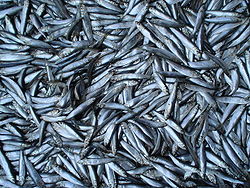- Docosanoid
-
In biochemistry, Docosanoids are signaling molecules made by oxygenation of twenty-two-carbon essential fatty acids, (EFAs), especially Docosahexaenoic acid (DHA). They include some resolvins and the docosatrienes.
Docosatrienes contain conjugated triene structures generated from DHA as a defining feature.[1]
Neuroprotectins
The protectins comprise docosatrienes and resolvins of the D series that are both neuroprotective and anti-inflammatory. [2] Neuroprotectin D1 is formed in retinal pigment epithelial cells when they are confronted with oxidative stress, in the brain during experimental stroke, and in the human brain from Alzheimer's disease patients as well as in human brain cells in culture. Neuroprotectin D1 displays potent anti-inflammatory and neuroprotective bioactivity.[3]
These substances are extremely potent. Neuroprotectin D1 and the 17S series resolvins are potent into the picomolar range.[4]
Neurofurans are docosanoids formed nonenzymatically by free radical mediated peroxidation of DHA.
Others
Cyclooxygenase and Cytochrome P450 oxidase act upon adrenic acid to produce dihomoprostaglandins[5] and dihomo-EETs,[6] respectively.
References
- ^ Serhan CN (2005). "Novel eicosanoid and docosanoid mediators: resolvins, docosatrienes, and neuroprotectins". Current opinion in clinical nutrition and metabolic care 8 (2): 115–21. doi:10.1097/00075197-200503000-00003. PMID 15716788.
- ^ Bazan NG (2006). "The onset of brain injury and neurodegeneration triggers the synthesis of docosanoid neuroprotective signaling". Cell. Mol. Neurobiol. 26 (4-6): 901–13. doi:10.1007/s10571-006-9064-6. PMID 16897369.
- ^ Bazan NG (2007). "Omega-3 fatty acids, pro-inflammatory signaling and neuroprotection". Current opinion in clinical nutrition and metabolic care 10 (2): 136–41. doi:10.1097/MCO.0b013e32802b7030. PMID 17285000.
- ^ Hong S, Gronert K, Devchand PR, Moussignac RL, Serhan CN (2003). "Novel docosatrienes and 17S-resolvins generated from docosahexaenoic acid in murine brain, human blood, and glial cells. Autacoids in anti-inflammation". J. Biol. Chem. 278 (17): 14677–87. doi:10.1074/jbc.M300218200. PMID 12590139.
- ^ Campbell WB, Falck JR, Okita JR, Johnson AR, Callahan KS (1985). "Synthesis of dihomoprostaglandins from adrenic acid (7,10,13,16-docosatetraenoic acid) by human endothelial cells". Biochim. Biophys. Acta 837 (1): 67–76. PMID 3931686.
- ^ Yi XY, Gauthier KM, Cui L, Nithipatikom K, Falck JR, Campbell WB. (2007 May). "Metabolism of adrenic acid to vasodilatory 1alpha,1beta-dihomo-epoxyeicosatrienoic acids by bovine coronary arteries.". Am J Physiol Heart Circ Physiol. 292 (5): H2265–74. doi:10.1152/ajpheart.00947.2006. PMID 17209008.
Categories:- Docosanoids
- Biochemistry stubs
Wikimedia Foundation. 2010.

